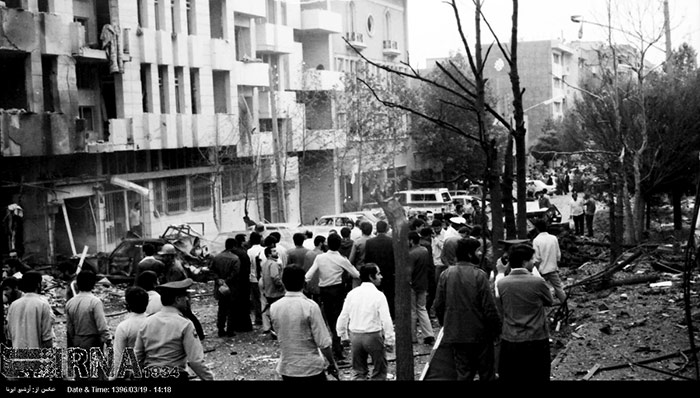Although it was not common among the armed oppositions of the Pahlavi regime to attack the press, the Mojahedin-e Khalq Organization, for the first time, hit a magazine titled This Week which was being published in Tehran. It was launched in 1965 in English and from 1970 to 1972, it was printed in Persian as well. This magazine was the only pornographic magazine in Iran.
The editor of this magazine was Javad Alamirdolou, an experienced press agent who was a reporter in Ettela’at newspaper and Journal de Téhéran, manager of the Jam-e-Jahan Nama magazine, representative of Office de Radiodiffusion Télévision Française, and reporter of the L’Express and Le Monde.
On May 2, 1972, the magazine’s office was exploded (Ettela’at newspaper No.13785, p4) which attracted a lot of attention. The blast led to the injury of 5 people (3 men and 2 women) (Political Studies and Research Institute, the case of This Week Magazine). According to one of the perpetrators of this attack, the MEK had selected a day when all editorial board members had gathered together in a meeting (Morteza Alviri’s memoirs, Islamic Development Organization, 1996).

This Week; a Magazine that Fell Victim to MEK Violance
Former mayor of Tehran and a member of the MEK at the time, Morteza Alviri who established the Fallah organization, played a role in the bombing incident. He was responsible for identifying and making a sketch of the magazine office. He writes in his memoire:
“A magazine titled This Week was being distributed in which sexy photos were printed. It was the only magazine with nude pictures at the time. I felt responsible to stand against this magazine. I talked to Vahid Afrakhteh in that regard and told him that such magazines would be detrimental to the youth- who are our future fighters- and that we had to stop this magazine from perverting their minds. If the magazine’s office were blown up, people would develop better feelings towards the MEK.”
Vahid Afrakhteh shared my idea with the organization and they agreed with it. Afrakhte asked me to locate the office. It was on Shah Street (currently the Jomhouri-eslami Street). I provided Afrakhte with the address.
Not more than a few days had elapsed when I read in the newspaper, “Office of This Week magazine has been blown up”. The MEK had picked a time when all members of the editorial board were present at the office.
On the following day, Vahid Afrakhteh asked me in our meeting to keep the bombing incident secret and be really careful. However, the newspapers raved and wrote extensively about it. Anyhow, the explosion created a positive reaction and that magazine was closed for good.
The news of the explosion spread in the newspapers like wildfire for a couple of days and heightened on May 6, 1972, after a trade of fire on Khorshid St. between security forces and two bombers. One police officer and one of the suspects were killed in the shootout and the second was arrested. Ettela’at daily’s report of the events was as follows: “following the last week’s bomb explosion in the office of This Week magazine and the British Overseas Airways Corporation office, law enforcement and security forces arrested saboteurs in their hideout. A police officer identified as Second Lieutenant Ala’eddin Javid was martyred. One of the saboteurs was gunned down and the second, trying to slip away, was arrested. The downed saboteur was identified as Ali Asqar Montazeri Haqiqi, one of the members of the so-called Liberation Movement whose ringleaders, apprehended with a huge cache of arms, had been tried, and convicted.” (Ettela’at, May 8, 1972).
Following the news of Khorshid St. gun battle, other newspapers published the news of a shootout on Farhang St. and named the dead saboteur as Habib Rahbari (Ettela’at, May 9, 1972, p. 1). What matters most is that the newspapers i.e. the Shah’s security service a.k.a. SAVAK placed the responsibility of the blast on the Mujahedin-e Khalq (a.k.a. MEK, MKO, and PMOI) or according to the newspapers the “Liberation Movement”.
Despite other armed attacks, MEK did not publish a statement taking credit for the bombing. However, Mahdi Rezaei stated in his defense in the District Court in September 1972: “Before I was arrested, we conducted an operation, including detonating a bomb in the office of This Week. […] I was not involved in the bombing and later I found out that five of the staff and directors of the magazine were injured.” (Ibid, pp. 76-77)
Attached is the then Information Ministry’s report of the exploded building and the injured.
This explosion should be regarded as a string of blasts started back in 1970s by some groups’ armed and guerilla war.
Following the Fadaian Khalq’s attack against the Siahkal Gendarmerie post on February 8, 1971, MEK planned to blow up a power station to disrupt the August 1971 celebration to mark the 2500th anniversary of the Persian monarchy. However, they failed and so many arrests were made. Some 70 members and leaders of the group ended up in Shah’s prison. Twelve out of 13 major leaders of the group as well as 9 other members were executed. According to General Nasiri, the then head of SAVAK, Massoud Rajavi’s sentence had been mitigated to life imprisonment due to his effective cooperation with SAVAK.
Following the execution of its leaders, MEK carried out a string of terrorist attacks, including raiding a Police station in Tehran in May 1972, exploding the office of This Week due to fostering the western culture in Iran, bombing the tomb of Reza Shah and the facilities of several US companies in Iran, including Pepsi Cola, General Motors, Shell Oil, Hotel International, Pan-Am Airlines, etc.
https://www.habilian.ir/en/202202074494/articles/this-week-a-magazine-that-fell-victim-to-mek-violance.html

